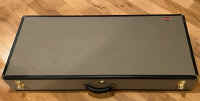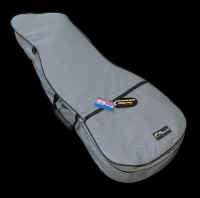

|
John Westling 20-string Harp Guitar SOLD
|
|
Own a true
piece of harp guitar history! Someone
should someday do a study on all the 20-string (“super-treble”)
instruments built after John Doan’s historic Sullivan-Elliott
concert harp guitar was completed in 1986. The list and timeline of
luthiers who did so is important and still undocumented. The best
clues can be found throughout my Harpguitars.net blog and pages, and
also commercial “used listing” sites like the very one you are on.
There have
been dozens of luthiers in the last couple decades who were either
inspired by John Doan’s instrument or built a copy of his instrument
from the GAL plans,
but I’m talking about in the beginning. There was of
course John
Sullivan himself, then the Milburns
and a fellow named Charles
Shifflett. But there was also a guy named John Westling,
who would go on to found Sandpiper Instruments, where he would eventually
concentrate on small harps. I’ve already sold one of his custom
instruments here. This offering is now only the second. Apparently,
these instruments are undated, and I was surprised to see how early he
had started his distinctive “rounded take” on the Sullivan-Elliott
harp guitar; apparently by the mid-1990s! The current owner (who some of you may know – Ande Flavelle) bought this fascinating harp guitar secondhand from John Westling himself back in 2001. It had come back to John at some time who installed a new back and later added electronics for the current owner. The pickup system is quite unique, so be sure to read the detailed write-up below. Me, I’m an acoustic guy, and was more interested in the tone. I actually owned the other Westling Sandpiper instrument, and (looking back) see that I described it as sounding as good or better than the Milburn that passed through my hands (which is saying something). But Ande’s instrument was built with the strings passing over the bridge to be held at the instrument's rim. Great for string tension and top bellying, but what about tone? As this instrument is not in my hands but in North Carolina with Ande (an old HG friend I trust implicitly), I’m now going to turn things over to him, editing and jumping in when and if necessary. My customers trust my non-hyped, blunt and honest evaluations, and I’ve asked Andy to do the same (which he did, wonderfully!). I also asked him to shoot a playing position photo, just to get an idea of the size and shape of the bulbous body in one's lap. He declined, but had a 6' friend pose for us: Introduction “John built this harp guitar to accommodate either steel strings or silk & steel on the guitar neck. (The super-trebles are steel strings, mostly in the .010 to .012 gauge range as memory serves.) I have always used steel strings on the guitar neck because I like the tone, plain and simple. String spacing at the bridge is 5/16" between all strings. Gregg asked me to try to describe the sound. Compared to my Milburn, the Westling seems more warm but subdued, more reminiscent to me of a mahogany soundboard but still lovely and unique. And amplified its truly a knockout; just beautiful. “I have
experimented with different tunings and gauges on this instrument over
the years, but have recently put it back in standard tuning with new
strings. The sub-basses are F-G-A-B-C-D, low-to-high. As for sub-bass strings, both John Westling and Gregg Miner specifically advise
not to use steel core
strings or phosphor-bronze-wrapped strings because this particular HG
was not designed to withstand those considerably higher pounds of
stress. Nylon core strings are more of a hassle to string up due to
their inherent stretchiness but that’s the nature of the beast. “Frankly
I prefer the tone of nylon
sub-bass strings. On the plus side, I find them smoother – less
harsh to my ears. On his web page Gregg describes the similar Westling
Sandpiper HG he sold where the nylon-core sub-bass strings had ‘a
nicer, deeper "oomph," but little else (like sustain).’ I
agree with Gregg’s description. But for me, the lack of long sustain (that steel-core strings can often deliver)
works quite well. In fact I prefer
the nylon core strings in part for exactly this reason. I find it
annoying to have that darn bass string going on and on while I’ve
just gone through the next 3 chords of the song on the guitar neck.
For tone and volume, I find the nylon core strings work beautifully,
especially when using an amplifier. [Totally get it, Ande. If
predominately plugging in and gigging, harp guitarists should strongly
consider the type of subs they may actually want for those particular
conditions. I’m a pretty proficient sub-damper, but had to pay much
more attention to it when playing my (steel-subs) SB Merrill plugged
in and cranked up at the restaurant. – GM] “A
negative to nylon sub-bass strings is that – due to their
stretchiness – you can wind up with a lot of string on the tuner
post end that can build up and slip off the top of the tuner post if
you’re not careful. I recently told Gregg that – were I to keep
this instrument – I would take off those six sub-bass tuners and
have a machinist drill a small threaded hole on the top of each one.
Step 2 would be to have the machinist create a small post that
threaded into the hole just
made in the tuner post, (kinda like a dentist does – minus the
threading – if you’ve ever had a cap put onto a tooth.) And, on that
post (that is to be screwed into the tuner post) will be secured a
flat circular top – perhaps 2/3’s the size of a dime – that
blocks the string wrappings from wanting to jump off. This is exactly
what I had asked to be done on a couple of the sub-bass tuners on the
Millburn HG I have and it worked like a charm. [Very clever, Ande!
I had the same problem with that otherwise fantastic Milburn I sold.
– GM] String details (GM) You might spot that most of Ande's photos show slender sub-basses. These were for an old experimental tuning of his. The neck and sub strings were since changed and the instrument is now tuned to standard tuning (neck and bass). You'll see these strings just in the main head-on shot and the one of his friend with the instrument. Note that the new subs had been sitting around a while and show tarnishing (from the coiled wrap), but sound "as new." My remaining stock of LaBellas are just long enough to thread onto Ande's instrument, but stock is now limited, and La Bella informs me they will no longer make harp guitar strings. (Others - Pyramid, etc. - continue to make nylon harp guitar strings, and I plan to investigate new string sources in Europe for the future.) Materials “The top
of mine is koa, the back and sides are cocobolo, the back having been
replaced by John before I bought it. The fretboard is rosewood,
binding is black plastic. I would assume the tuners are the same as in
your other Sandpiper listing, based on visual inspection vs. your
photos there. Modifications “As
mentioned, my harp guitar was later modified by John. In addition to
replacing the back of the instrument before I bought it (and then
installing my design for the unique pick-up configuration described
below), John did some work on the headstock, after rethinking his
design. Specifically, he removed a seventh sub-bass tuning peg
for a string that is no longer there (leaving six subs). At any rate,
John apparently didn’t want to go to the trouble of putting on an
entirely new bridge so he left the original one as is. In the photos
of the beveled string attachment at the tail, you can see that
there’s an extra bridge pin hole visible that is unused where John
decided to remove this 7th string (red arrow), but there is
nothing visible on the headstock to indicate its absence. [Though
we can’t specifically recommend it, I would not discount the
possibility of one-day re-extending the headstock and adding a
7th sub back on. If the top is as flat as Ande says, then
it’s not yet being over-taxed. - GM] Condition Electronics "Back in the mid-90’s I looked long and hard to find a pick-up that would most uniformly capture all three string banks of this harp guitar and with a decent sound representation. To that end I tested several pick-ups of different manufacturing origins before selecting one as the answer to that challenge. The one that worked the best for me was the LR Baggs “I-Beam”, an active “microphonic” pick that did everything I wanted it to do. (Actually, LR Baggs techs would not describe the I-Beam as a pick-up per se, and the term “microphonic” they came up with (and still use) gives a better label – if not a much better description – for it.) All I know is that it does the job I was seeking. To my ears, the sound quality of the guitar signal coming from the amp is far closer to the way one would actually hear it coming out of the guitar, acoustically; meaning the sound coming from the guitar soundboard straight through the air directly to your ears. No 'quack' or other cringe-worthy sounds one often hears with generic piezo pick-ups. (Note: the word “active” that’s used here means the I-Beam is battery driven; no phantom power is needed but you will have to change 9-volt batteries from time to time.)
"The above being said there is a potential for even more, for I also designed and arranged for 3 other pick-ups to be installed in this harp guitar: one for each of the 3 banks of strings, with each pick-up's signal to go out to a different amp, should that be desired. Unfortunately, the pick-up for the super-treble bank of strings is on the fritz. I’m not sure why; it could an age-related issue. Frankly I didn’t use that option very often, and I suspect most readers won’t much care much about fixing it either, but still, those more exotic harp guitar and multiple amp combinations are potentially available. Extras "The instrument comes with an Ameritage custom hard shell case (like new condition) and a Colorado custom soft case (like new condition), both included in the price." Conclusion
(Ande) “In
summary, this is a used instrument. It has also been repaired and modified
by the
builder, John Westling. He repaired two top cracks, replaced the back and removed a sub-bass
tuner (although you’d never know were it not for the unoccupied
bridge pin hole). Two hairline back cracks remain. That
said, quite frankly none of this discouraged me when I bought it nor
would discourage me now. It’s a wonderful instrument. I have
meticulously maintained it and it also comes with added benefits like
the fantastic-sounding LR Baggs pick-up. I consider it a classic harp guitar built by a renowned luthier and
harp maker, a true player’s instrument.” And GM:
As I said at the top, this is a super rare (and somewhat unusual)
now-historical instrument…and still going strong! John hasn’t
built one in decades. Go check other luthiers for what something like
this might run, then come (crawling) back! Ande and I are ready for
this to go to its next home. - Gregg "Sir Gregory" Miner Price:
SOLD |
||
|
Specifications:
Price:
$4250 |
||

|

|
|
|
CDs &
DVDs by Stephen Bennett, John Doan, Muriel Anderson, Andy McKee,
Stacy Hobbs, Tom Shinness, Dan LaVoie, James Kline, Larry
Berwald, Bill Dutcher, Gregg Miner, Pasquale Taraffo |
All Site Contents ©
2006-2023

We've
moved!
Harp Guitar Music
PO Box 401
Middlefield CT 06455
USA
(860) 894-7504